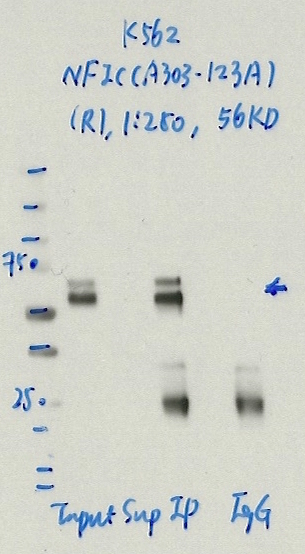ENCAB272JJF
Antibody against Homo sapiens NFIC
Homo sapiens
K562
characterized to standards
Homo sapiens
any cell type or tissue
partially characterized
- Status
- released
- Source (vendor)
- Bethyl Labs
- Product ID
- A303-123A
- Lot ID
- 1
- Characterized targets
- NFIC (Homo sapiens)
- Host
- rabbit
- Clonality
- polyclonal
- Purification
- affinity
- Aliases
- michael-snyder:AS-1427
- External resources
Characterizations
NFIC (Homo sapiens)
K562
compliant
- Caption
- Immunoprecipitation was performed on nuclear extracts from the cell line: K562, using the antibody A303-123A. The blot shows western blot analysis of input, flowthrough, immunoprecipitate and mock immunoprecipitate using IgG.Molecular Weight: 55.675
- Reviewer comment
- Multiple bands but marked band >50% of total signal in lane.
- Submitted by
- Denis Salins
- Lab
- Michael Snyder, Stanford
- Grant
- U54HG006996
- Download
- 1082_10_NFIC_A303-123A.jpg
NFIC (Homo sapiens)
Method: motif enrichment
compliant
- Caption
- The motif for target NFIC is represented by the attached position weight matrix (PWM) derived from ENCFF754CMK. Motif enrichment analysis was done by Dr. Zhizhuo Zhang (Broad Institute, Kellis Lab) using known motifs (http://compbio.mit.edu/encode-motifs/) and previously published ChIP-seq data (http://www.broadinstitute.org/~zzhang/motifpipeline/data/TrainSetInfo.txt). The accept probability score of the given transcription factor was calculated using a Bayesian approach. This analysis also includes three motif enrichment scores, computed by overlapping the motif instances with the given ChIP-seq peak locations, as well as an enrichment rank. For more information on the underlying statistical methods, please see the attached document. Accept probability score: 0.782993677673 Global enrichment Z-score: 12.1115624676 Positional bias Z-score: 15.5882769627 Peak rank bias Z-score: 9.02263392304 4 Enrichment rank: 1.0
- Submitted by
- Jessika Adrian
- Lab
- Michael Snyder, Stanford
- Grant
- U54HG006996
NFIC (Homo sapiens)
not reviewed
- Caption
- Immunoprecipitation was performed on nuclear extracts from the cell line K562 using the antibody A303-123A. Lane 1: input nuclear lysate. Lane 2: material immunoprecipitated with antibody. Lane 3: material immunoprecipitated using control IgG. Marked bands were excised from gel and subjected to analysis by mass spectrometry. Target molecular weight: 55.675.
- Reviewer comment
- Not reviewed because this antibody has already been fully characterized in K562.
- Submitted by
- Nathaniel Watson
- Lab
- Michael Snyder, Stanford
- Grant
- U54HG006996
- Download
- NFIC_A303-123A.JPG
NFIC (Homo sapiens)
Method: immunoprecipitation followed by mass spectrometry
not reviewed
- Caption
- IP followed by mass spectrometry. Briefly, protein was immunoprecipitated from K562 nuclear cell lysates using the antibody A303-123A, and the IP fraction was loaded on a 10% polyacrylamide gel (NuPAGEBis-Tris Gel) and separated with an Invitrogen NuPAGE electrophoresis system. The gel was stained by ColloidialCoomassie G-250 stain, gel fragments corresponding to the bands indicated were excised. Then proteins were trypsinized using the in-gel digestion method. Digested proteins were analyzed on an Orbitrap Elite mass spectrometer (Thermo Scientific) by the nanoLC-ESI-MS/MS technique. Peptides were identified by the SEQUEST algorithm and filtered with a high confidence threshold (Peptide false discovery rate < 1%, 2 unique peptides per protein minimum, mass error < 10 ppm).
- Submitter comment
- None of the proteins ranked above or equal to NFIC are sequence-specific TFs.
- Reviewer comment
- Not reviewed because this antibody has already been fully characterized in K562.
- Submitted by
- Nathaniel Watson
- Lab
- Michael Snyder, Stanford
- Grant
- U54HG006996
- Download
- NFIC_A303-123A_final.pdf
